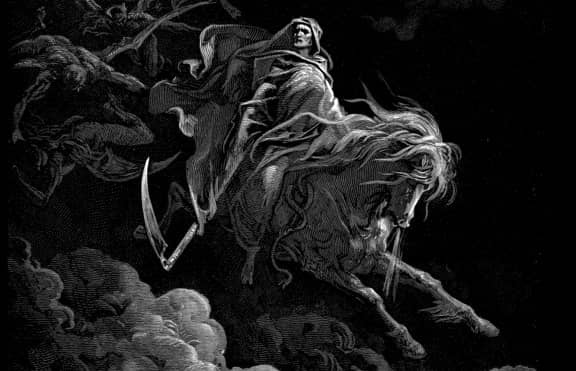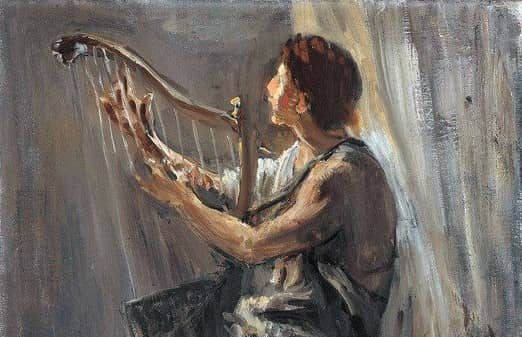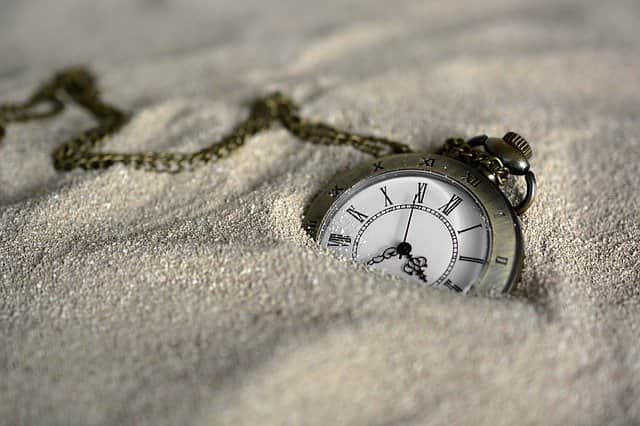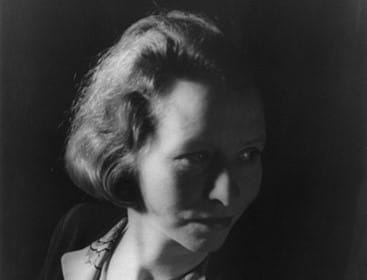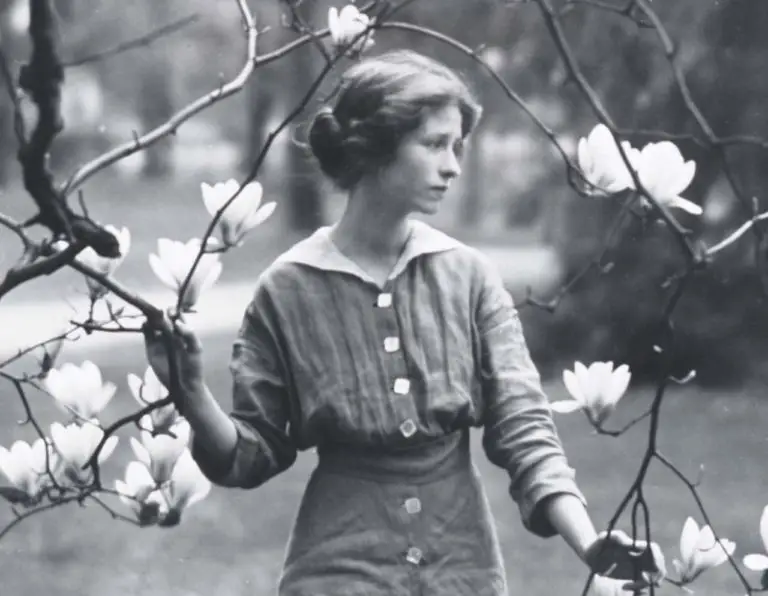An Ancient Gesture by Edna St. Vincent Millay
“An Ancient Gesture” was published in Edna St. Vincent Millay’s posthumous collection, Mine the Harvest in 1954. This poem is about a speaker who likens her emotional state to that of Penelope, a character from Homer’s epic Odyssey. Penelope waited for twenty emotionally tedious years with the hope that her husband, Ulysses’ return. Her story of loneliness, uncertainty, and heartache is what features in this poem through the “authentic,” “antique” gesture of wiping tears with the corner of an apron. In this poem, Millay shows how one woman has to suffer for the sake make others happy even though she has no conviction that she would finally be happy or not.
- Read the full poem “An Ancient Gesture” below:
An Ancient Gesture by Edna St. Vincent Millay I thought, as I wiped my eyes on the corner of my apron: Penelope did this too. And more than once: you can’t keep weaving all day And undoing it all through the night; Your arms get tired, and the back of your neck gets tight; And along towards morning, when you think it will never be light, And your husband has been gone, and you don’t know where, for years, Suddenly you burst into tears; There is simply nothing else to do. And I thought, as I wiped my eyes on the corner of my apron: This is an ancient gesture, authentic, antique, In the very best tradition, classic, Greek; Ulysses did this too. But only as a gesture,—a gesture which implied To the assembled throng that he was much too moved to speak. He learned it from Penelope … Penelope, who really cried. - from Mine the Harvest (1954)
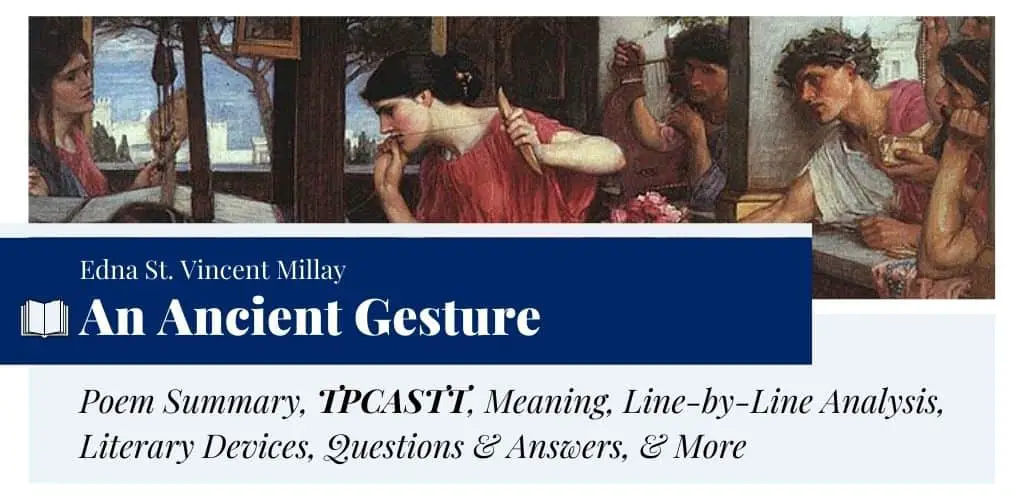
Summary
Millay’s “An Ancient Gesture” is about a speaker who wipes her eyes (not tears) on the corner of her apron. While doing so, she thinks Penelope, the wife of Ulysses (or Odysseus) did this too as a daily task when her husband was out for years. To prevent herself from committing infidelity, she weaved a shroud, another “gesture” of stalling, throughout the day and unwove the same piece during the night. In this process, she, the speaker thinks, became tired and suddenly burst into tears as there was simply nothing she could do.
In the second stanza, the speaker notes that Penelope’s gesture is genuine and bears the mark of the classical tradition, featured in the great Greek epic by Hope. This gesture directs how women (especially wives) should behave in the case of an absent husband. Furthermore, the speaker contrasts Penelope’s gesture of genuine sadness with Ulysses’ strategic gesture of shedding tears to avoid addressing the public. Sarcastically, she says that Ulysses learned it from Penelope.
Meaning
The title, “An Ancient Gesture” hints at some act that upon repetition for generations beginning from the classical age has become a tradition of femininity. This “gesture” is what Millay’s speaker relates with as she also undergoes somewhat a similar situation. Nonetheless one cannot say she actually does undergo a sense of uncertainty as Penelope waiting for her husband’s return. This poem contains a sense of objectivity while discussing the traditional role of women suffering alone for the absence, or most precisely, “otherness” of their husbands. It can also be interpreted as a glorification of women’s silent suffering, an echo of Dickinson’s idea in “To fight aloud, is very brave –”.
Structure & Form
A free-verse poem with no set rhyme scheme or meter, “An Ancient Gesture” consists of two stanzas with nine and eight lines each. The length of lines is also irregular. Millay’s use of longer lines expresses the speaker’s thoughtfulness and unnoticeable ache. She writes the poem from the perspective of a first-person speaker, by using a powerful and witty voice. The poem begins with “I thought” incorporating subjectivity to the universal theme of silent suffering.
Though this piece does not have a set rhyming pattern, readers can find a few instances of rhymes scattered across the text. For instance, the fourth, fifth, and sixth lines end with the rhyming words “night,” “tight,” and “light.” Right next, the lines end with a similar rhyme: “years” and “tears.” Then to rhyme “do” in the last line of stanza two, readers have to look back to the second line, specifically at “too.” Similarly, in the second stanza, “antique” (line 11) rhymes with “Greek” (line 12) and “speak” (line 15). And “implied” rhymes with “cried.”
Literary Devices & Figurative Language
Millay uses the following literary devices in her poem “An Ancient Gesture”:
Allusion
There is an allusion to Penelope, the wife of the main character of Homer’s Odyssey, Odysseus or Ulysses. The poet specifically alludes to the story of Penelope’s suffering when her husband was out to fight in the Trojan Year and did not return for twenty years. In order to delay marrying, she devised a strategy of weaving a shroud for her father-in-law and undoing it all through the night. Besides, in line 13: “Ulysses did this too,” there is an allusion to Ulysses’ return and his fake gesture of crying in order to avoid speaking to the public.
Metaphor
In the first stanza, the reference to “weaving” is a metaphor for heartache and suffering. The speaker says, “when you think it will never be light.” This reference makes the comparison clearer. She tries to say that the pain is never going to be lighter or reduced.
Anaphora
Anaphora occurs in lines 3-4 and lines 6-7. Millay begins these lines by using “And,” signaling a sense of continuity. This recurrence of the same word at the beginning of successive lines also creates an interconnection between the ideas. Another variation of anaphora, known as anadiplosis, occurs in the last two lines. The last word of line 16, “Penelope” is repeated at the beginning of the last line for the sake of emphasis.
Asyndeton
Asyndeton is the deliberate omission of conjunction between parts of a sentence. One can notice how Millay uses “And” often in the first stanza. In contrast, she does not use the conjunction at all in the second stanza; for instance, in “This is an ancient gesture, authentic, antique,/ In the very best tradition, classic, Greek.” The omission is, indeed, used for poetic effect.
Repetition
This device is used in line 14: “But only as a gesture,— a gesture which implied.” The speaker tries to mean that Ulysses’ act of shedding tears is a mere “gesture” devoid of the genuine emotion of sadness, unlike Penelope. Moreover, there is another repetition at the end where the poet intentionally refers to “Penelope” twice to highlight her genuineness and importance (in the poet’s story).
Line-by-Line Analysis & Explanation
Lines 1-4
I thought, as I wiped my eyes on the corner of my apron:
Penelope did this too.
And more than once: you can’t keep weaving all day
And undoing it all through the night;
The poem is not titled “The Ancient Gesture”; it is “An Ancient Gesture.” Edna St. Vincent Millay starts to surprise readers from the very beginning. Her poem is not about the “act,” rather it is about “an” insignificant “gesture” that Homer failed to glorify in his epic, Odyssey. He went a great deal to deliberate on the moral and ethical sides of crying. A hero, in his case, Ulysses, must not cry publically. Else, his subject will take him as an emotionally unstable ruler. He needs to be emotionally strong enough to hide his pain.
Millay applies the same reasoning to Ulysses’ wife, Penelope’s case. In her story, Penelope is the “hero” and Ulysses is placed at the sidelines. He fakes and she fights. The speaker begins the poem by likening her gesture of wiping her eyes on the corner of her apron, to that of Penelope. It is important to note, the speaker wipes her “eyes,” not the tears. So, there is no explicit comparison between their emotional states in this analogy. She just thinks that Penelope did this “act” too.
While Ulysses was out for twenty long years, Penelope repeated this “gesture” more than once. In the beginning, she might be truly emotional. As the years passed on, the act of missing her husband became a habit, a mere gesture. None can keep weaving (or specifically stalling) all day long and undo it through the night. In Homer’s story, Penelope could manage to do this for only three years.
Lines 5-9
Your arms get tired, and the back of your neck gets tight;
And along towards morning, when you think it will never be light,
And your husband has been gone, and you don’t know where, for years,
Suddenly you burst into tears;
There is simply nothing else to do.
In these lines, Millay’s speaker directly addresses the audience and welcomes them to participate in her thought process. She gives them a case to imagine: a wife is weaving and weaving all day long and untying the pattern throughout the night for the sake of keeping her busy in some futilely productive vocation. At some point, her arms will get tired and the back of her neck will get stiff. In this way, her physical pain will somehow discourage her to carry on the weaving.
After undoing the day’s work throughout the night, she will realize the next morning that all her pain is never going to lessen. Her husband has been gone for years. On top of that, she is not even sure of his return (Dickinson also elaborates on this in her poem “If you were coming in the Fall”).
In the given scenario, what should the wife do? She suddenly burst into tears not for the husband’s lack of responsibility for her, but for her utter helplessness. There is no possible way out for her to be happy. First few years, it seemed easy enough to live with the good memories. But, after waiting for five or as long as ten to fifteen years, she finds it quite impossible to remember one good memory to cheer her up. Those memories start to haunt her now. Thus, the speaker says, “There is simply nothing else to do.” (Note the use of the term “simply” and “else” for the sake of emphasis.)
Lines 10-12
And I thought, as I wiped my eyes on the corner of my apron:
This is an ancient gesture, authentic, antique,
In the very best tradition, classic, Greek;
At the beginning of the second stanza, the speaker repeats the first line to draw readers’ attention to the action of wiping her eyes. She is possibly doing some domestic chores, such as cutting onions, dusting, etc. Something might have gone to her eyes and she is possibly trying to remove it with the corner of her apron. Whatsoever, then she alludes to Penelope’s act of wiping her tears as “an ancient gesture” that is both “authentic” and “antique.” Furthermore, it has become a “tradition,” dating back to the classical age. Women, for generations, have repeated this gesture several times, in similar circumstances.
Lines 13-17
Ulysses did this too.
But only as a gesture,—a gesture which implied
To the assembled throng that he was much too moved to speak.
He learned it from Penelope …
Penelope, who really cried.
In line 13, Millay uses the same sentence pattern but replaces “Penelope” with “Ulysses.” He performed the “gesture,” by not really diving into the emotional aspect. His “gesture” implied that he was much too moved to speak to the assembled throng of Ithaca. In the next line, the speaker ironically says he learned it from Penelope.
One can learn a gesture or an act easily, but to understand the emotions behind the act one needs to have prior experience. Penelope “really” cried while Ulysses shed mere tears like the speaker when something went into her eyes. Besides, according to the speaker, Ulysses failed to empathize with her wife’s desperation and helplessness. He only mimicked what he learned from her as he thought her emotions were nothing other than a “gesture.”
TPCASTT of “An Ancient Gesture”
Explore the TPCASTT of “An Ancient Gesture” below. You can also explore our step-by-step TPCASTT guide.
| T | Title | The title of Millay’s poem “An Ancient Gesture” somehow hints at the subject matter of the poem. Thus, it’s an interactive title that gives a key to unlock the main idea. Primarily, it seems Millay’s alluding to some unspecified “gesture” or “an” act. She does not use definitive “The.” That’s why the title is about some “ancient” or old act that the speaker personally feels is worth noting. It may have significance in her life. |
| P | Paraphrase | The speaker thought as she wiped her eyes on the corner of her apron that Penelope did that too. She did it more than once. A woman cannot keep weaving all day and unweaving it all through the night. At some point, the arms get tired, the back of the neck gets tight. Towards the morning, she thinks the pain is never going to reduce. While her husband has been gone for years and she does not know when he will return. Suddenly, she bursts into tears as there is simply nothing else to do. The speaker thought once again, that is an ancient gesture, authentic and genuine itself. This gesture has become a tradition, dating back to the classical Greek period. Ulysses also did it. He did it only as a gesture which implied to the crowd that he was too moved to speak. He learned it from Penelope, who really cried. |
| C | Connotation | This free-verse poem has a sporadic rhyming pattern with uneven line lengths. The poet uses repetition, metaphor, and allusion. She draws an episode from Homer’s Odyssey to highlight a universal, timeless theme from a different perspective. |
| A | Attitude/Tone | The attitude or tone of the speaker is empathetic, ironic, rational, and objective. She deals with the subject quite in a matter-of-fact manner. |
| S | Shift | The shift in the subject matter occurs when the speaker starts talking about Ulysses’ “gesture,” devoid of authentic emotions. According to the speaker, he learned the “act,” not the pain behind it. |
| T | Title | After understanding the poem’s main idea, the title makes more sense than the first reading. It is about Penelope’s “gesture” of wiping her tears while her husband was absent. That act has been repeated for generations of wives, yet there is no definitive recognition of such heroic, inward suffering of women. Thus, the poet uses “An” in place of “The.” |
| T | Theme | The main theme of the poem is the universal suffering of women (as wives) for their absentee husbands. The act of crying is an ancient gesture of emotional instability, helplessness, and desperation. Besides, this poem also taps on the theme of genuine emotions versus fake emotional gestures. |
Historical Context
Millay’s “An Ancient Gesture” first appeared in vol. 66 of The Ladies’ Home Journal in 1949. Therefore, Millay wrote this poem primarily for women who could relate to Penelope’s pain. She somehow tried to make them think how women’s heroic mental struggle is often undermined in popular culture. Their silent suffering is overshadowed and their better halves fail to recognize or sympathize with their pain. Millay’s husband, Eugen Jan Boissevain died in 1949 the same year she wrote this piece. So, through this poem, she tried to showcase her emotional instability and hopelessness. After Millay’s death, her sister Norma published the poem in Mine the Harvest in 1954.
Questions and Answers
“An Ancient Gesture” by Edna St. Vincent Millay is about a speaker (housewife) who thinks about Penelope’s silent suffering for her absent husband while wiping her eyes with the corner of her apron. She is of the view that her “gesture” is both genuine and antique, bearing the mark of feminine tradition. Thus, she can relate to her inward battle the most and not to Ulysses’ gesture of shedding a tear or two in order to imply he was too moved to speak.
One of the well-known poems of Edna St. Vincent Millay, “An Ancient Gesture” is similar to Homer’s epic Odyssey. In the epic, Homer glorifies the act of hiding one’s true emotions in order to portray oneself as strong or sympathetic. While in Millay’s poem, the act of inward suffering is glorified. So, for Homer, Ulysses is the hero and for Millay, Penelope is the leading figure who showcases the qualities of integrity, self-restraint, and honesty more aptly.
“An Ancient Gesture” was written in 1949 and first published in volume 66 of The Ladies’ Home Journal in the same year. It was later included in her posthumous book of poetry, Mine the Harvest published in 1954.
The title of the poem is primarily effective because it aptly hints at the main idea that is about the inward suffering of Penelope and the “gesture” of crying.
The ancient gesture is the act of crying out of desperation and hopelessness. Millay refers to Penelope’s genuine emotional outburst as “an ancient gesture.”
The main theme of the poem is the emotional suffering of women for their husbands’ absence. It also explores themes of the genuineness of emotions, fake gestures, and glorification of women’s suffering.
The tone of the poem is practical, sympathetic, ironic, and a bit helpless.
The speaker of the poem is a modern housewife who likens her state to Penelope’s distress caused by her husband Ulysses’ absence.
Penelope’s “gesture” is genuine unlike that of Ulysses. His is a mere “gesture” devoid of authentic emotions.
Millay uses the story of Penelope’s emotional turbulence due to her husband Odysseus’ long absence in order to portray the modern theme of women’s inward struggle/suffering for their absentee husbands. It is important to note that Millay’s mother Cora divorced her husband and moved out with her daughters. Therefore, Millay herself likened her state after her husband’s death in 1949 to those of her mother and Penelope.
Similar Poems about Women’s Suffering
- “The Ballad of the Harp-Weaver” by Edna St. Vincent Millay — This poem is about a mother’s pain at the sight of her poor boy in dire need of clothes.
- “To fight aloud, is very brave –” by Emily Dickinson — It’s about individual hardships and struggle that is as much important as physical battles.
- “The Woman” by Kristina Rungano — This piece records one Zimbabwean woman’s suffering in marriage.
- “I’m “wife” — I’ve finished that —” by Emily Dickinson — In this poem, a speaker proclaims her independence from servitude as a wife.
External Resources
- Check out Savage Beauty: The Life of Edna St. Vincent Millay (2002) — Explore this portrait of a passionate, fearless woman, Millay, who obsessed Americans ever as she tormented herself, written by Nancy Milford.
- The Poem Aloud — Listen to this reading of Millay’s poem “An Ancient Gesture.”
- A Musical Performance — Watch this dramatic performance of the poem with music by Sheila Silver.
- About Penelope — Read about one of the most creative thinkers in Odyssey, Penelope.
- About Edna St. Vincent Millay — Learn about the poet’s life and her influential works.

